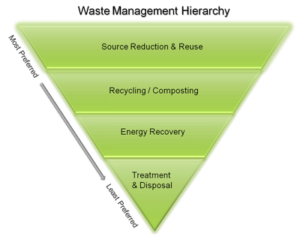Emily Tipaldo is the Director of Plastics Packaging and Consumer Products for the American Chemistry Council
Recycling clearly is a critical component of materials management. It’s widely accepted that recycling can preserve resources, reduce energy use, and limit greenhouse gas emissions. Plus, burying valuable materials such as recyclable plastics in landfills is simply a waste of resources.
While healthy recycling markets are vital to sustainability, it’s also important to note that recycling is not the sole measure of sustainability. At the top of the waste management hierarchy is: reduce. Using less in the first place typically leads to the greatest contributions to sustainability.

To provide a much richer measure of sustainability, Sustainable Materials Management (SMM) looks at the entire lifecycle of materials, packaging, and products to help us make more informed choices. As the U.S. EPA notes: “SMM represents a change in how our society thinks about the use of natural resources and environmental protection. By looking at a product’s entire lifecycle we can find new opportunities to reduce environmental impacts, conserve resources, and reduce costs.”
In short, SMM seeks to establish an explicit, overarching materials management goal, beyond just recycling, to reduce the environmental impact of materials.
Two recent studies contribute greatly to our understanding of the environmental impacts of materials throughout the various stages of their life cycle, a key aspect of SMM. In 2014, the consulting firm Trucost produced a study for the United Nations Environment Programme that looked at the total natural capital cost of plastics used in the consumer goods industry. This cost is calculated by assessing a range of environmental impacts such as manufacturing, marine debris, and the loss of valuable resources when used plastics are sent to landfills rather than recycled.
In 2016, Trucost expanded on that study and compared the environmental cost of using plastics in consumer products and packaging to the cost of replacing plastics with alternative materials.
The findings? When compared, the new study found that the environmental cost of using plastics is nearly four times less than the costs of using other materials. Substituting plastics with alternatives that perform the same function would increase environmental costs from $139 billion to $533 billion annually.
These findings may well be surprising to many people. But given the nature of plastics, it probably should not be all that unexpected. Among others, one of the likely reasons for these findings is the favorable strength-to-weight ratio of plastics. Alternative materials certainly can be viable alternatives to plastics in many consumer goods applications. But a greater amount of these alternatives typically is needed to meet the same objective.
In fact, this new study finds that alternatives require four times more material by mass on average. While the environmental costs of alternative materials can be slightly lower per ton of production, they are greater in aggregate due to the much larger quantities of material needed to fulfill the same purposes as plastics.
Using more efficient packaging material, for example, results in important environmental benefits throughout the life of the package—even after we use it. A shift toward lightweight film packaging is one reason why brand owners already are realizing significant reductions in packaging.
As noted, this study contributes to our application of SMM by comparing the environmental costs of various materials we use. By using advanced decision-making tools made possible by this and similar lifecycle studies, we can make more informed decisions about what we produce and how we produce it—and be more open and transparent about why we make those decisions. The study also points out that, regardless the comparative costs, more needs to be done to reduce the impact of plastics and other materials.
SMM is gaining significant momentum, propelled by a growing consensus around the scientific approach of lifecycle analyses as the most comprehensive way to assess the impacts of materials, products, and packaging. EPA and progressive states such as Oregon and Minnesota are rapidly moving towards SMM.
As noted at the outset, recycling plays a key role in sustainability. Preventing materials from becoming part of the waste stream can significantly reduce environmental costs. Plastics makers are spending considerable resources to improve the efficiencies and volume of plastics recycling, one of many reasons the U.S. is recycling more plastics than ever.
While these are welcome gains, we also must recognize the broad environmental costs of various materials, as well as the many sustainability issues beyond solid waste, so we all can make the most informed decisions.
Categories
Sustainable Materials Management and Natural Capital Valuation Provide a Richer Measure of Sustainability


